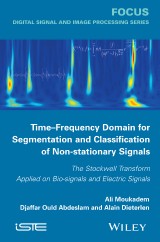Details

Time-Frequency Domain for Segmentation and Classification of Non-stationary Signals
The Stockwell Transform Applied on Bio-signals and Electric Signals1. Aufl.
|
139,99 € |
|
| Verlag: | Wiley |
| Format: | |
| Veröffentl.: | 06.03.2014 |
| ISBN/EAN: | 9781118908778 |
| Sprache: | englisch |
| Anzahl Seiten: | 148 |
DRM-geschütztes eBook, Sie benötigen z.B. Adobe Digital Editions und eine Adobe ID zum Lesen.
Beschreibungen
<p>This book focuses on signal processing algorithms based on the timefrequency domain. Original methods and algorithms are presented which are able to extract information from non-stationary signals such as heart sounds and power electric signals. The methods proposed focus on the time-frequency domain, and most notably the Stockwell Transform for the feature extraction process and to identify signatures. For the classification method, the Adaline Neural Network is used and compared with other common classifiers. Theory enhancement, original applications and concrete implementation on FPGA for real-time processing are also covered in this book.</p>
<p>Preface ix</p> <p><b>Chapter 1. The Need for Time–Frequency Analysis 1</b></p> <p>1.1. Introduction 1</p> <p>1.2. Stationary and non-stationary concepts 2</p> <p>1.2.1. Stationarity 2</p> <p>1.2.2. Non-stationarity 4</p> <p>1.3. Temporal representations 5</p> <p>1.4. Frequency representations of signals 6</p> <p>1.4.1. Fourier transform 7</p> <p>1.4.2. Mean frequency, bandwidth and frequency average 10</p> <p>1.5. Uncertainty principle 12</p> <p>1.6. Limitation of time analysis and frequency analysis: the need for time–frequency representation 15</p> <p>1.6.1. Instantaneous frequency 15</p> <p>1.7. Conclusion 18</p> <p>1.8. Bibliography 19</p> <p><b>Chapter 2. Time–Frequency Analysis: The S-Transform 21</b></p> <p>2.1. Introduction 21</p> <p>2.2. Synthetic signals 22</p> <p>2.3. The STFT 22</p> <p>2.4. The WT 24</p> <p>2.5. The Wigner–Ville distribution 25</p> <p>2.5.1. The pseudo-WVD 27</p> <p>2.5.2. The smoothed PWVD 27</p> <p>2.6. Cohen’s class 28</p> <p>2.7. The S-transform 29</p> <p>2.7.1. Properties of the S-transform 30</p> <p>2.7.2. The discrete S-transform 38</p> <p>2.7.3. The improvement of the S-transform energy concentration 41</p> <p>2.7.4. The ST-spectrogram 51</p> <p>2.8. Conclusion 56</p> <p>2.9. Bibliography 56</p> <p><b>Chapter 3. Segmentation and Classification of Heart Sounds Based on the S-Transform 61</b></p> <p>3.1. Introduction 61</p> <p>3.2. Methods and materials 64</p> <p>3.2.1. Data sets 64</p> <p>3.2.2. Localization and segmentation of heart sounds 65</p> <p>3.2.3. Classification of heart sounds 70</p> <p>3.3. Results and discussion 73</p> <p>3.3.1. Localization and segmentation results 73</p> <p>3.3.2. S1 and S2 classification results 77</p> <p>3.3.3. Murmur detection results 80</p> <p>3.4. Conclusion 82</p> <p>3.5. Bibliography 83</p> <p><b>Chapter 4. Adaline for the Detection of Electrical Events in Electrical Signals 87</b></p> <p>4.1. Introduction 87</p> <p>4.2. Electric events 88</p> <p>4.2.1. Power quality 88</p> <p>4.2.2. Electric events 89</p> <p>4.3. Adaline 90</p> <p>4.4. Adaline for frequency estimation 91</p> <p>4.4.1. Adaline method 91</p> <p>4.4.2. Results 94</p> <p>4.5. Adaline for voltage component extraction in unbalanced system 97</p> <p>4.5.1. Model of the unbalanced voltage system 98</p> <p>4.5.2. Extraction of the voltage components in the DQ-space 99</p> <p>4.5.3. Online estimation of the instantaneous phases θd and θi 100</p> <p>4.5.4. Filtering the AC components in the DQ-space 101</p> <p>4.5.5. Results 104</p> <p>4.6. Adaline for harmonic current identification and compensation 108</p> <p>4.6.1. Adaline method 110</p> <p>4.6.2. Results 115</p> <p>4.7. Conclusion 117</p> <p>4.8. Bibliography 118</p> <p><b>Chapter 5. FPGA Implementation of the Adaline 121</b></p> <p>5.1. Introduction 121</p> <p>5.2. Instantaneous power theory (IPT) in the APF 122</p> <p>5.3. Adaline for the computing of the IPT in the PLL 123</p> <p>5.3.1. Adaline-based PLL 123</p> <p>5.3.2. A multiplexing approach for hardware consumption reduction 126</p> <p>5.4. Results 129</p> <p>5.4.1. Simulation 129</p> <p>5.4.2. FPGA implementation results 130</p> <p>5.5. Conclusion 132</p> <p>5.6. Bibliography 133</p> <p>Index 135</p>
<strong>Ali Moukadem</strong> is a post-doctoral researcher at the MIPS laboratory at the University of Haute Alsace in France. His research interests include time-frequency analysis, multi-resolution analysis, non-stationary signals, and biomedical signals. <p><strong>Djaffar Ould Abdeslam</strong> is Associate-Professor at the University of Haute Alsace in France. His research interests include advanced and intelligent methods for power quality improvement and monitoring, the control of Active Power Filters (APF) with ANNs and fuzzy logic and the hardware implementation of ANNs. <p><strong>Alain Dieterlen</strong> is Professor at the MIPS laboratory at the University of Haute Alsace in France. His research interests include instrumentation, image and signal processing.


















